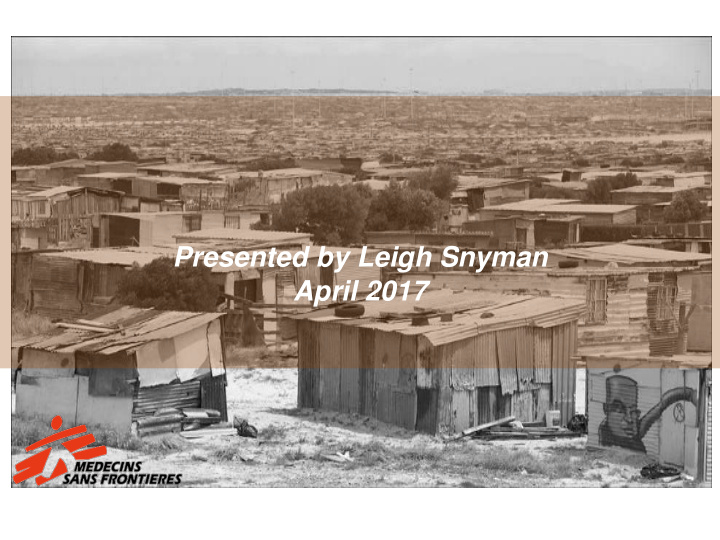



Presented by Leigh Snyman April 2017
Overview • Definition of Palliative Care • Case based discussion • Take home messages
What is Palliative Care? WHO Definition of Palliative Care: Palliative care is an approach that improves the quality of life of patients and their families facing the problems associated with life- threatening illness Methods: • Prevention and relief of suffering • Assessment and treatment of pain and other problems, physical, psychosocial and spiritual WHO 2010
Palliative Care in Phases Diagnosis Curative/ life prolonging therapy Clinical Management Palliative Terminal Phase management
Palliative Care in Phases Palliative Curative/ life management prolonging therapy • Relieve patient from suffering • Diagnosis Cure disease • Manage symptoms • Manage adverse • Protect patient events/ side effect autonomy • Complete treatment • Patient centered care Clinical and achieve • Good treatment Management treatment success journey whatever the outcome Terminal Phase
Case study: Patient X • 27 year old man • HIV negative (confirmed) • Unemployed, lives alone • No child contacts • Previous DS-TB in 2011 – cured • March 2015 – presented with new TB symptoms • GXP pos RR-TB, on sputum • Culture pos, res to RIF and INH, inhA only, sus to Ofx and Ami – MDR • April 2015 – clinically stable and ambulant • Commenced standard MDR treatment
Case study • July 2015 (month 3) – Monthly sputum cultures contaminated – Interrupted treatment for 6 weeks • August 2015 – Returned to care – stable and weight increased, but coughing and night sweats back again – August sputum culture negative – Resumed MDR treatment (with Kana) at end Aug • Dec 2015 (month 8) – Culture positive again since Oct, losing weight – Abscess at injection site – Kana withdrawn – Considered MDR treatment failure – offered strengthened regimen with BDQ, LZD and CFZ
Case Study • Jan 2016 (month 1 new regimen) – Sputum culture pos, res to RIF, INH and Ami – pre-XDR – Continued regimen: • PZA / BDQ / CFZ / LZD / LFX / TRD / hdINH • June 2016 (month 6 new regimen, [mth 14 total]) – No culture conversion (lots of contaminated samples), still culture positive in June – No weight gain, bilateral extensive disease – Adherence reasonable – attending clinic in the week – BDQ withdrawn (6 months completed, Tx failing) – Considered pre-XDR treatment failure
Case example • Aug 2016 (month 15 total) – Still on PZA / CFZ / LZD / LFX / TRD / hdINH – Not eligible for surgery, or for NIX trial – Case presented to NCAC and Provincial M/XDR Review Committee – all agreed to withdraw treatment and manage palliatively – But patient refused and begged to continue! – Commenced palliative pathway… ( Leigh) • Nov 2016 (month 18 total) – Still on treatment, much improved on morphine and with access to oxygen in sub-acute facility – Discovered Aug sputum culture negative…
Case example • Jan 2017 (month 20 total) – Still on PZA / CFZ / LZD / LFX / TRD / hdINH – Still on morphine but no longer on oxygen – Four monthly sputum cultures negative , but slow clinical improvement – Patient wanted info about other available options… – Sputum submitted to Pretoria for extended DST – Application submitted to add DLM and Meropenem to regimen, and restart BDQ, along with current regimen • Mar 2017 (month 22 total) – Admitted to BCH for monitoring, IV port inserted, now on salvage regimen, and hopeful!
Case study: Patient X • Treatment failing? • Hope failing? • Body failing? • Friends/ family failing? • The Health care system failing?
Relieving suffering • Continued TB medication on pt. request • Encourage Hope while ensuring patient had insight into situation • Assess and treat the Body • Educate Friends/ family • Support the Health care system – Access to medication, sputum test, respite care, emergency admissions and isolation
Ethical Issues to Note • Patient Autonomy versus Patient Review Board decision • Public harm: infection control implication of patients staying in the community • Patient Harm- limited access to care • Justice- Equal access to life saving treatment, care and support
Conclusions • Cases confirm: – Living with a life threatening disease is challenging – Relieving suffering is possible at community level – Sufficient care provision at community level often does not happen from MSF’s experience with various cases – Palliative care provision is not a reflex response
Recommendations • Prioritization of RR-TB Palliative Care Guidelines drafted by South Africa for implementation in 2016 • Palliative care training for HCWs need to be prioritized at national and provincial level • Partnerships between district health services and district Palliative Care services are key to implement services at community level • New Drugs + Trained HCW + Resources = Hope for the future
Recommend
More recommend